Present Day Railroad Tracks
*Place cursor on image to magnify
Two sets regional railroad tracks run through Norwich today. The railroads are now solely used to transport cargo. The black outline shows the boundaries of Norwich. The New England Central tracks, shown as a red line, travel along the west side of the Thames River from New London through Norwich to Canada. The trains that run on these tracks are operated today by the New England Central Railroad which is a subsidiary of Genesee & Wyoming.
The Providence and Worcester tracks, shown as blue lines, run south from Norwich along the east side of the Thames River through New London on to Providence. The P&W track also runs north from Norwich to Plainfield. At Plainfield the tracks split, and continue on to either Worcester or Willimantic. The trains that run on these tracks are operated by Providence & Worcester Railroad which is a subsidiary of Genesee & Wyoming.
Over the years, these railroads have been known by several different names because they have been owned and operated by many different railroad companies.
1876 Norwich Transportation System
*Place cursor on image to magnify
The map above is an 1876 snapshot in time of downtown Norwich. The town was booming. Hugh Henry Osgood was Mayor, Ponemah Mills was one of the largest textile mills in the United States, the Yantic Woolen Mill was in full operation, and there were more than six active gun manufacturers.
The combination of access to both a rail system and a port helped to make Norwich be one of the most important transportation hubs in New England. Its system of railroads and steamships provided manufacturers, merchants and individual passengers easy access to central New England, New York and Boston markets.
The first major development in the transportation system came in 1840 when the Norwich & Worcester Railroad opened. This line provided direct, railroad access from central New England to the port city of Norwich. At Norwich, cargo and passengers could be transferred to and from a steam ship headed to either New York or Boston. By the time this map was drawn, the Norwich & Worcester Railroad had been extended down to New London. And, the newer company, the New London Northern Railroad had built a line along the western banks of the Thames River that connected Norwich to New London, central Vermont, and even Canada.
The map also shows the locations of the two railroad stations at that time, the Norwich & Worcester Depot (#2 on map) and the New London Northern Depot (#7 on the map). The New London Northern Depot was replaced by Union Depot (#6 on the map) in 1891.
1840-Present
Providence & Worcester Railroad
The Providence & Worcester Railroad that runs through Norwich today has been owned and operated by several different companies over the years. In 1840, the Providence & Worcester Railroad (then owned and operated by the Norwich & Worcester Railroad) was the first railroad to connect Norwich to Central New England. The original construction only included a single line from Norwich to Worcester.
The original railroad also included a 300-foot long tunnel near Taftville. The Taft Tunnel was the first common carrier tunnel to be built in the United States. It is still in operation today in its original form.
The Norwich & Worcester Depot, (located near downtown Norwich) stood at the beginning of the original Norwich & Worcester Railroad. It served as a passenger terminal.
The composition and types of locomotives powering the trains on the P&W has changed dramatically over the years. The placemarks below contain a brief summary of the history of development of the Norwich Depot, the trains, rails, and companies of the Providence & Worcester Railroad.
Choose A P&W Railroad Topic
1840-1898 Norwich & Worcester Railroad
*Place cursor on map to enlarge
Charles Rockwell was the Mayor and he knew that Norwich needed a railroad to support its burgeoning manufacturing interests. Before moving to Norwich, Charles and his brother John had played a role in various enterprises associated with the development of railroads in other parts of the United States. They were experienced railroad developers.
In 1832 a group of engineers and surveyors laid out the proposed Norwich & Worcester Railroad. The detailed path, shown on the left, winds its way from New London, Ct. through Norwich Ct., Jewett City Ct. and Webster, MA to Worcester, MA
Construction of the Norwich & Worcester Railroad on the first section of rail that spanned between Norwich and Worcester began on November 18, 1835.
*Place cursor on image to magnify
In 1837 Charles Rockwell was the President the Norwich & Worcester Railroad and was the Mayor of Norwich. With his experience in railroad development and knowledge of civic affairs, he had the ability to greatly further the development of the Norwich transportation system. The opening of the first section of tracks, 59 miles long, in 1840 was a major milestone for Norwich.
Passengers and freight could now easily travel between central New England and New York or Boston. Once rail passengers arrived in Norwich from central New England they could board one of the two steamboats (also owned by the Norwich & Worcester Railroad) headed to either New York or Boston.
Sometimes, in the middle of winter, the mouth of the Thames in Norwich can freeze over. In times like this the steam boats could not make it all the way to Norwich from New London. To remedy this problem, a second section of rail was laid between Norwich and Allyn Point. The green line on the map shows the location of the second section. This line was opened in 1843. This second section is 6 miles long.
Forty-six years later in 1889, the third section was built by the New York, New Haven and New England Railroad. This section, 6 miles long, connected Allyn Point to Groton. It is shown as a blue line on the map. Passengers could now complete a journey from Central New England to Groton without boarding a boat.
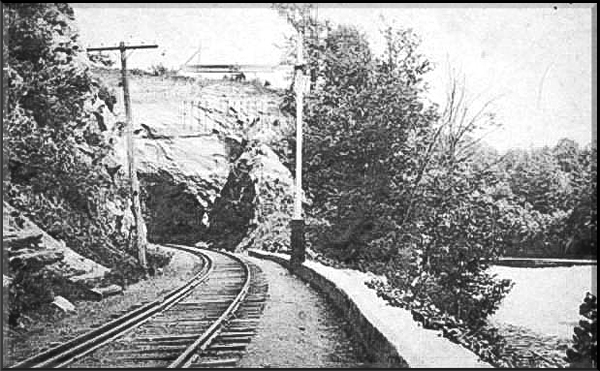
The Taft Tunnel, is 300-foot long and it cuts through Bundy Hill. its creation involved skillful engineering, an abundant amount of blasting powder, and many strong backs. The location of the tunnel is shown on the map above. Construction was completed and it was ready for rail to be laid on August 27, 1837. Some passenger and freight service began in September 1839, however, the Norwich & Worcester Railroad did not officially open until March 9, 1840.
At its opening, the Taft Tunnel had the honor of being the first common carrier railroad tunnel in the United States.
Within a decade, the line began to build its own locomotives and cars in a large shop in Norwich. The Norwich & Worcester Railroad also owned a succession of fine passenger steamers like the City of Worcester and City of Lowell. These boats carried passengers to/from New York and Boston from Norwich.
In 1898, when the New York, New Haven and New England Railroad purchased the Norwich & Worcester Railroad Company, it took control of a substantial operation. Today the line is part of the Providence & Worcester Railroad’s regional freight system owned by Genesee & Wyoming.
The book, “The Quickest Route – The History of the Norwich and Worcester Railroad,” by Elmer Farnham provides a much more detailed history of the Norwich & Worcester Railroad.
Acknowledgements
Richard Malley, Your Public Media
Connecticut Historical Society
Wikipedia
The complete list of sources may be found by clicking the “Bibliography” button, and, then entering “Norwich & Worcester” in the SEARCH box.
1859-1969 Norwich Train Station
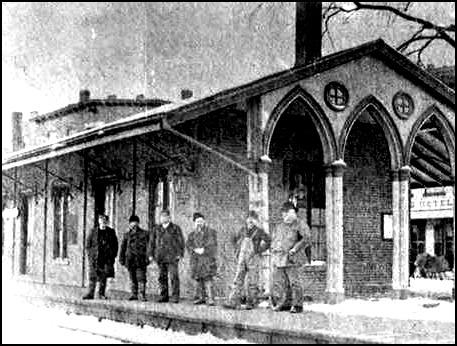
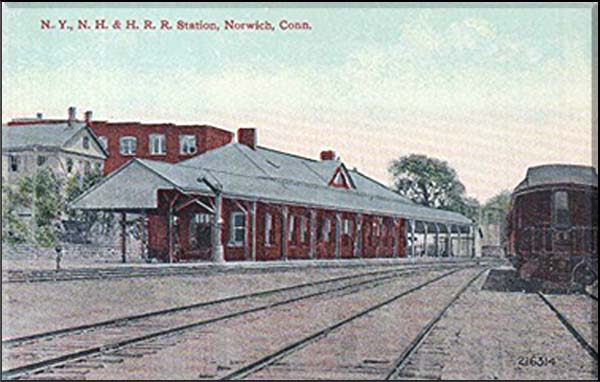
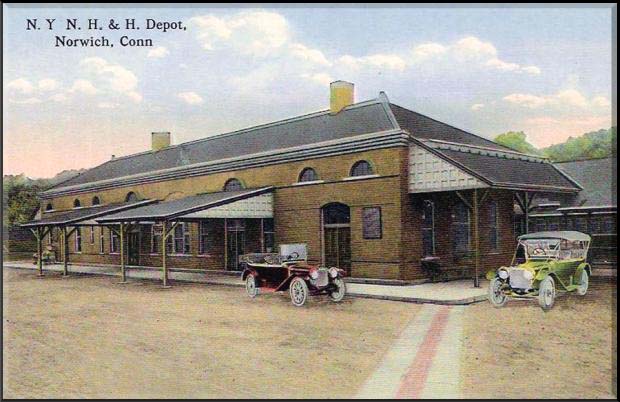
The photo on the left shows the first Norwich train station. It opened its doors in 1859 and was used as the passenger terminal for the Norwich & Worcester Railroad. At that point-in-time it was called the “Norwich & Worcester Depot”. The middle and right postcards illustrate Norwich’s second train station. It was built approximately 250-feet from the original, first station.
The middle postcard shows how from the station appeared from the train side, looking northwest. And, similarly, the right postcard illustrates the view from the street side, looking northeast. The middle and right postcards are circa 1910.
With four daily passenger and freight connections each way to Worcester, Norwich became a major transportation center with steamboat shipping to New York City through Long Island Sound. The route was the preferred Boston to New York route was via the Norwich and Worcester Railroad through Norwich.
Until the Thames River was bridged in 1889, Chelsea Harbor had full warehouse and passenger terminals with its favorable access to central New England.
After the Norwich & Worcester Railroad was acquired by the New York, New Haven and Hartford Railroad (commonly known as The New Haven) in 1898, the building became known as the “New York, New Haven and Hartford Station” and the “New York, New Haven and Hartford Depot”.
Acknowledgements
Thanks to Rob Ladd for contributing information and image to this placemark.
“Prosperity Echoes in the City’s Past”, 05/23/2010, by Bill Stanley
Public Domain, Thomas J. Dodd Research Center, University of Connecticut
Public Domain
FamilyOldPhotos.com
The complete list of sources may be found by clicking the “Bibliography” button, and, then entering “Norwich Train Station” in the SEARCH box.
1873-1893 New York & New England Railroad

The New York and New England Railroad was a major railroad connecting the southern portion of New York state, Hartford CT, Providence RI and Boston, MA. It operated under the name of New York and New England Railroad from 1873-1893. It was envisioned as a direct route between New York City and Boston, and to be built to bypass the shoreline route of the New York, New Haven & Hartford Railroad (NYNH&H).
The portion of the railroad, just north of Norwich, which connects Willimantic to Plainfield is shown in the map above.
The most well-known and prestigious train of the New York & New England Railroad was the New England Limited of 1891, an express Boston – New York passenger train. The Pullman Palace Car Company refitted the train with luxurious new cars decorated in white and gold, inspiring the advertising department to call it the White Train. Folks along the line called it the Ghost Train as it sped through their towns after dark. It caught the romantic imagination of New Englanders, even after it was long gone.
The New York and New England Railroad company went bankrupt in 1893. It was briefly reorganized, however, by 1898 it was sold to the NYNH&H. The sale included the section of railroad that connects Willimantic to Plainfield, slightly north of Norwich.
Acknowledgements
WikiVisually
WikiMedia Commons
1898-1968 New York, New Haven & Hartford Railroad
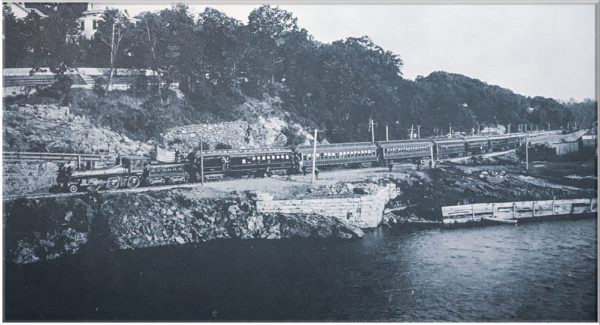
In 1898 the Norwich & Worcester Railroad was acquired by the New York, New Haven and Hartford Railroad, (NYNH&H) commonly known as the New Haven. Prior to the acquisition the Norwich & Worcester the tracks only extended south from Norwich to Allyn Point. NYNY&H completed the construction of the line between Allyn Point and Groton in early 1899.
The blue lines in the map above show the Norwich & Worcester Railroad tracks that were acquired by the NYNY&H Railroad company (plus the last section of track between Allyn Point and Groton that was added soon after the acquisition).
The photo on the left shows the NYNH&H Taftville Depot on August 16, 1916.
*Place cursor over image to magnify.
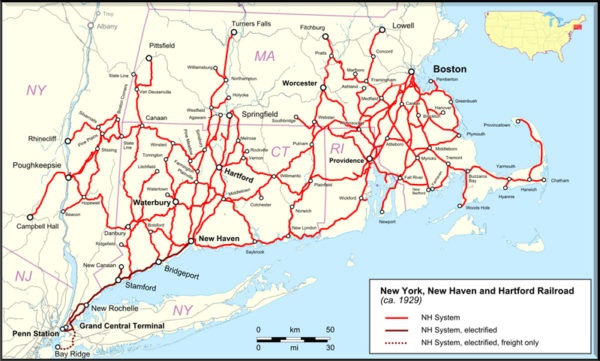
N&W company ceased to exist and the NYNH&H company expanded. Note that in 1898, when the acquisition occurred the Norwich & Worcester Railroad had already incorporated the old New York & New England Railroad into its network.
The Norwich & Worcester acquisition was a part of New York banker J.P. Morgan’s monopolization of New England’s transportation system in the late 1890’s. His acquisitions included 49 other railroads, several steamship lines, and a network of electrified trolley lines that provided interurban transportation for towns like Norwich.
Many passengers and cargo were transported by the NYNH&H Railroad from Norwich to all parts of New England and to other parts of the world.
This photo above shows troops from Norwich going off to support the World War I efforts in 1917.
Prior to 1950 the NYNH&H trains were powered by steam locomotives. The 1940’s photo above shows the last steam locomotive leaving on the NYNH&H line in Norwich.
History
The NYNH&H Railroad operated in Norwich from 1891-1968. It dominated the region’s rail traffic for the first half of the 20th century. It went bankrupt in 1935. After it was reorganized and reduced in scope, NYNH&H Railroad subsequently went bankrupt again in 1961.
On January 1, 1969 the NYNH&H merged with the Penn Central Railroad. Unfortunately, a year later in 1970, Penn Central declared bankruptcy. At that point-in-time it was the largest bankruptcy in the U.S. history. Later, in 1976, the rail lines in Norwich (remnants of the original Norwich & Worcester Railroad) were purchased by the Providence & Worcester Railroad. Please refer to the placemark below for details.
The remnants of the defunct New York, New Haven and Hartford Railroad system now forms the basis for Metro-North Railroad’s New Haven Line, and parts of Amtrak’s Northeast Corridor, Shore Line East, the Massachusetts Bay Transportation Authority (MBTA) and freight operators such as CSX and the Providence & Worcester Railroad. The majority of the original NYNH&H system is now owned publicly by the states of Connecticut, Rhode Island, and Massachusetts.
Acknowledgements
Wikipedia – New York, New Haven and Hartford Railroad
Wikipedia – New York, New Haven and Hartford Railroad
The complete list of sources may be found by clicking the “Bibliography” button, and, then entering “1872-1968 New York” in the SEARCH box.
1976-Present Providence & Worcester Railroad
Today’s Providence and Worcester Railroad is a Class II railroad owned by Genesee & Wyoming. The entire rail line system spans approximately 512 miles.
The trains still run through Norwich and pass by the old Train Station, now occupied by The Bulletin.
The locations of today’s Providence & Worcester (PW) lines are shown as thick, gold colored lines in the map below. The main lines run from: a)New London to Gardner, MA, and, b) Worcester to Providence, and c) North Haven to Hartford.
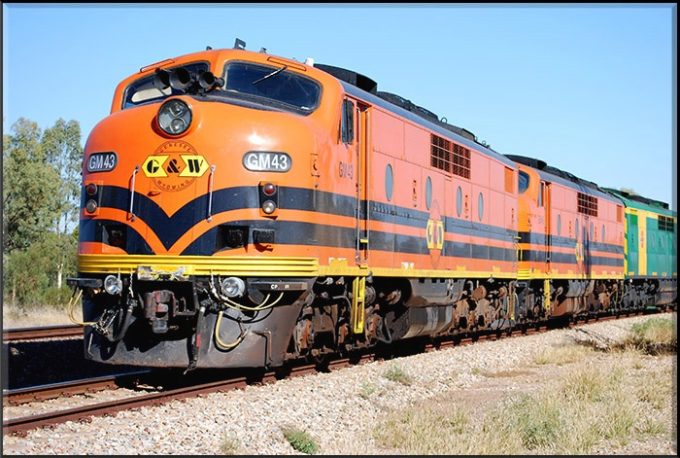
The Providence & Worcester Railroad now transports a variety of freight. The top commodities moved are: autos, auto parts, chemicals, plastics, minerals, and stones.
History
After the NYNH&H went bankrupt in 1969, the P&W was bought by the Penn Central Railroad. However, Penn Central went bankrupt in the next year 1970. Providence & Worcester Railroad re-emerged three years later, on February 3, 1973, when they embarked on their inaugural run as an independent operating entity.
Since then, the railroad has acquired many other lines from the former Penn Central, the Boston and Maine Railroad Company, and Consolidated Rail Corporation. On January 3, 2017 the Providence & Worcester Railroad joined the family of Genesee & Wyoming.
Acknowledgements
Genesee & Wyoming
Genesee & Wyoming